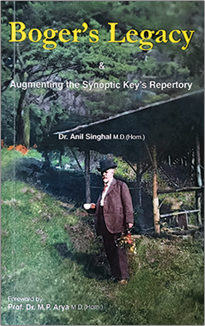Boger’s legacy and augmenting the synoptic key’s repertory: Dr. Anil Singhal - A Book Review
*Corresponding author: Dr. Anoop Mohan Nigwekar, Department of Repertory, Dr M. L. Dhawale Memorial Homoeopathic Institute, Palghar, Maharashtra, India. shriclinic25@gmail.com
-
Received: ,
Accepted: ,
How to cite this article: Nigwekar AM. Boger’s legacy and augmenting the synoptic key’s repertory: A book review. J Intgr Stand Homoeopathy. 2024;7:130-1. doi: 10.25259/JISH_37_2024

Book Title : Boger’s Legacy and Augmenting the Synoptic Key’s Repertory
Author : Dr. Anil Singhal
Publisher : Axis Media and Publishing Company, Gurugram, Haryana, India.
Year of Publication : 2023
Edition : First
Price : INR 500
Pages : 212
ISBN-10 : 9359679720
ISBN-13 : 978-9359679723
CONTENTS OF THE BOOK
Boger’s Journey: The making of a Homoeopathic Legend
Boenninghausen’s Repertory: The foundation of Boger’s Legacy
The Synoptic Key: The Apex of Boger’s Legacy
Augmenting the Boger’s Synoptic Key (BSK) Repertory: Proposing New Additions
Homoeopathic Timeline of Boger’s Legacy
In this book, the author begins his journey as a Postgraduate learner in 2002–2003, when he was attracted to the philosophy and practice of Dr. C. M. Boger. He has a unique gesture that comes out prominently of gratitude toward all who helped him in the journey of these 20 years in understanding Boger. This also brings out a personality who is keen to deliver the most correct document to the students of homoeopathy.
The premise of the need for augmenting the repertory section of the Synoptic Key with the help of Boger Boenninghausen’s Characteristic Repertory (BBCR) – has excited the author to build on the gap he has identified, which is the core delivery of the book.
The author has classified the BBCR into two editions, the original and another Indian. For BSK, he has enlisted six editions, of which 5th and 6th are editions, which are edited by Dr. N. K. Banerjee. He brings to bear the salient features of BSK and the supplementary reference table, which he has diligently tabulated.
He has taken the liberty as an author to propose conjunctures based on his logical thinking, which may need exploration. But I assume it will be difficult. He has been careful not to override his scholarship, too. He must be appreciated for having drawn the line on several occasions. All scholars must learn this art and skill of restraint, or else we will end up creating fictitious documents for the next generation to build upon.
He has compared the missing 5-mark remedies in similar rubrics of BBCR and BSK repertory section; he did not forget to add the note of caution that we should not be carried away by his findings and build a new BSK repertory section. He warns us to explore the remedies identified in our clinical practice and then build on personal experience and append in their personal BSKs these remedies in appropriate rubrics.
He has chronologically enlisted 160 milestone events in Boger’s life, a task made easy for future generations.
The author does delve into the philosophy of Boger and very astutely shares the core demand of the concept of time as envisaged by Boger and the concept of sphere of action of remedy. For both these concepts, the author has cited various masters (Dr. L. D. Dhawale, Dr. S.R. Phatak, Dr. P. Shankaran, Nobert Winter) and their efforts in decoding these two concepts.
It is indeed a book to be possessed by students who desire to learn about Boger, his books, and his philosophy. It is also a good representation of how a researcher can create a book based on his dissertation.
Ethical approval
The Institutional Review Board approval is not required.
Declaration of patient consent
Patient’s consent not required as there are no patients in this study.
Conflicts of interest
There are no conflicts of interest.
Use of artificial intelligence (AI)-assisted technology for manuscript preparation
The author confirms that there was no use of artificial intelligence (AI)-assisted technology for assisting in the writing or editing of the manuscript and no images were manipulated using AI.
Financial support and sponsorship
Nil.






